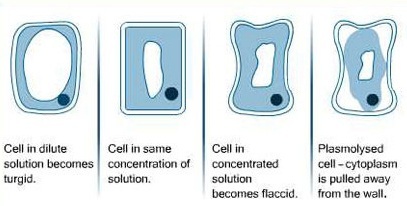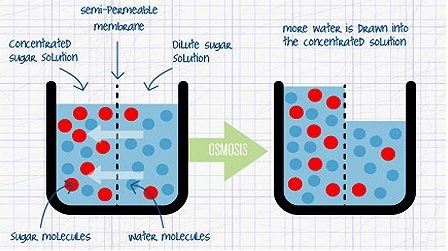- Water relations in plant cells differ with that in animal cells.
- A plant cell has both a cellulose cell wall and cell membrane.
- The centre of the cell contains vacuole with sap. The sap is a solution of salts and sugars and is bound by a membrane, the tonoplast.
- The cell membrane and tonoplast are semi permeable while the cellulose cell wall is fully permeable.
- Plant cell in hypotonic solution e.g. distilled water
- If a plant cell is placed in water or hypotonic solution, the cell will draw water from the hypotonic solution through osmosis causing the cell to distend.
- The cellulose cell wall is rigid and does not allow plant cells to burst as in the case of animal cells.
- As the cell gains more water, the vacuole enlarges and exerts an outward an outward pressure on the cell wall called turgor pressure.
- The turgor pressure increases as more water is taken into the vacuole causing the cell to stretch until the cell cannot stretch any more. The cell becomes firm and is said to be turgid.
- Turgor pressure is the outward pressure that the cell cytoplasm exerts on the cell wall as it gains more water through osmosis.
- When the cell wall is being stretched towards the outside, it will develop a resistant pressure to stretching that is equal and opposite to turgor pressure called wall pressure.
- A plant cell in a hypertonic solution
- When placed in a hypertonic solution, the plant cell will lose water to the solution through osmosis.
- As the water moves out of the cell, the cell starts to shrink, becomes less rigid or flabby and is said to be flaccid.
- It the cell loses more water, its contents reduce in size and the plasma membrane pulls away from the cell wall towards the centre.
- The process through which plant cells lose water, shrink and become flaccid is called plasmolysis.
- Plasmolysis can be reversed when a flaccid cell is placed in distilled water in a process called deplasmolysis.

Wilting
- Plants always lose water to the atmosphere through transpiration and evaporation.
- Simultaneously, the plant cells lose water and draw more from the soil.
- Wilting is a phenomenon that occurs when plant cells lose more water than they draw from the soil making the plant cells to lose their turgor pressure and droop.
- At night, plants always recover from wilting since stomata are closed and water loss through evapotranspiration is significantly reduced.
- Where water supply from the soil is inadequate, the plants may fail to recover from wilting and instead undergo permanent wilting.

